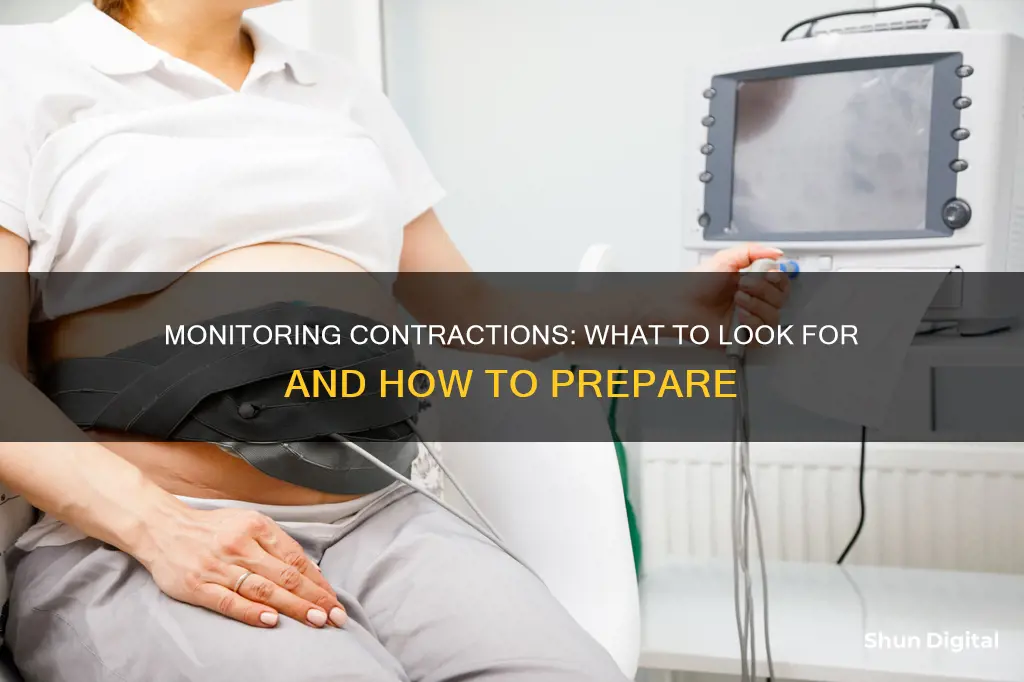
Monitoring contractions is an important part of assessing the health of the foetus and ensuring the safety of the mother and baby. This can be done in a hospital or at home, and there are two main types of contraction monitors: continuous and intermittent. Continuous monitors are the most common and display the response of the foetus's heart rate to the contractions in real-time, while intermittent monitoring refers to periodic monitoring of the foetus's heartbeat. Continuous monitoring is often used in labour and high-risk pregnancies, while intermittent monitoring is more common during check-ups for low-risk pregnancies.
| Characteristics | Values |
|---|---|
| What the monitor shows | How strong the contractions are, how long they last, and how far apart they are |
| What contractions look like on the monitor | Little mountains or peaks |
| How to read the monitor | The monitor will show two separate graphs, one for the baby's heart rate and one for contractions |
| Graphs' movement | Right to left, meaning the most recent information is on the right |
| X-axis | Time in minutes |
| Y-axis for baby's heart rate graph | Beats per minute |
| Y-axis for contractions graph | mmHg (millimeters of mercury) |
| Strength of contractions at the start of the active phase | 50-70 mmHg |
| Strength of contractions when the cervix is fully dilated | 80-100 mmHg |
What You'll Learn
- Continuous monitoring: a constant record of contractions and the baby's heartbeat
- Intermittent monitoring: periodic monitoring of the baby's heartbeat
- External monitoring: monitoring without inserting instruments into the body
- Internal monitoring: monitoring using equipment placed inside the body
- What to expect: how to interpret the monitor's graphs and what they indicate about labour?

Continuous monitoring: a constant record of contractions and the baby's heartbeat
Continuous monitoring is a method of monitoring fetal heart rate and uterine contractions. It is usually carried out in a hospital setting, with the mother-to-be hooked up to a contraction monitor. This monitor will display two charts: one showing the strength of the mother's contractions, and the other showing the baby's heart rate, measured in BPM (beats per minute). The monitor will also show the time in minutes, with each minute depicted within bold lines and lighter lines in between measuring 10-second increments.
The monitor will show the baby's BPM and the mother's contractions in the form of graphs, with lines moving from right to left, indicating the most recent data. The baby's heartbeats will line up with the contractions that are occurring at the same time. The monitor will show the strength of the contractions in mmHg (millimeters of mercury), with stronger contractions appearing as higher peaks.
Continuous monitoring is often used in labour and high-risk pregnancies. It is a useful tool to help doctors check on the health of the baby and ensure the safest pregnancy possible. It can also be used to detect early fetal distress and abnormalities in contractions, allowing doctors to take timely and correct treatment measures.
Reasons for continuous monitoring include fetal distress during labour, the use of an epidural, induced labour, pre-existing medical conditions, previous pregnancies, and previous caesarean sections.
Finding the Hz of Your LCD Monitor
You may want to see also

Intermittent monitoring: periodic monitoring of the baby's heartbeat
Intermittent monitoring, also known as auscultation, is the periodic monitoring of a baby's heartbeat during labour and birth. It is usually carried out during low-risk pregnancies and involves the use of a handheld Doppler device, a fetoscope, or an electronic fetal heart monitor. These devices are placed on or against the mother's abdomen to listen to the baby's heartbeat.
During intermittent monitoring, a healthcare provider will check the baby's heartbeat at specific intervals. This might be every 15 to 30 minutes during the active phase of the first stage of labour and every five to 15 minutes during the second (pushing) stage.
The provider will listen for the "baseline" heart rate, which is the baby's heart rate between contractions when the baby is not moving. A normal baseline heart rate is between 110 and 160 beats per minute. They will also listen to the heart rate during and shortly after contractions, which can indicate how the baby is tolerating labour.
Intermittent monitoring is generally considered just as effective as continuous monitoring for low-risk pregnancies. It is associated with fewer c-sections and forceps/vacuum deliveries and allows for more movement and comfort for the mother.
Easy Speaker Setup: Element Monitor and Desktop Edition
You may want to see also

External monitoring: monitoring without inserting instruments into the body
External monitoring is the most frequently used method to monitor contractions without inserting instruments into the body. This method is typically carried out in a hospital or doctor's office, but can also be done at home. It involves the use of a device called an ultrasound transducer, or a tocodynamometer (TOCO), which is strapped over the abdomen to monitor the baby's heartbeat and contractions. This device is connected to a monitor that displays the frequency, length, and power of the contractions in the form of graphs.
During external monitoring, a belt or band is wrapped around the waist and attached to the tocodynamometer. The machine records the contractions and transmits the data to a central viewing station, usually located in a hospital or clinic. Nurses assess the data and prepare a detailed report for the doctor. They can also provide guidance on how to apply the band and care for oneself during the monitoring process.
External monitoring allows for some movement, such as moving around on the bed or in a nearby chair. However, it is important to minimise movement as it can change the position of the transducer and interfere with the recording. The results should be checked every 10 minutes to identify any abnormalities.
This method of monitoring is particularly useful for detecting preterm labour, as it helps to assess the frequency of contractions per hour, which increases as a woman gets closer to delivery. It can also be used to monitor contractions during labour, providing valuable information about the health of the fetus and allowing for early intervention if necessary.
Connecting an External Monitor to Your iPad: A Step-by-Step Guide
You may want to see also

Internal monitoring: monitoring using equipment placed inside the body
Internal monitoring is a type of electronic fetal monitoring that is done during labour and delivery. It involves placing a thin wire (electrode) through the cervix and attaching it to the baby's scalp to monitor their heart rate. This is usually done after the cervix has dilated to at least 2 cm and the amniotic sac has ruptured. The electrode is connected to a recording device that can display or print out the baby's heart rate.
Another method of internal monitoring involves placing a small tube through the cervix and into the uterus to measure the strength and timing of contractions. This is often done if it is difficult to clearly record the baby's heart rate or the contractions with external monitoring.
Internal monitoring can be used to:
- Monitor the baby's heart rate
- Measure the frequency and duration of contractions
- Detect preterm labour
- Check the baby's health if there are concerns, such as insufficient oxygen, delayed growth, or maternal diabetes or high blood pressure
Cloud Usage Monitor: Understanding Cloud Consumption
You may want to see also

What to expect: how to interpret the monitor's graphs and what they indicate about labour
What to expect: how to interpret the monitors' graphs and what they indicate about labour
If you're giving birth in a hospital, your doctor will probably use continuous fetal monitoring to show your contractions on a monitor. This will likely be done by a process called electronic fetal monitoring, which looks at both the baby's heart rate and your contractions.
The monitor's screen will show two graphs, one stacked on top of the other. The top graph will usually show the baby's heartbeat, measured in beats per minute (BPM), and the bottom graph will show your contractions. The lines on the graphs will move from right to left, with the most recent information on the right.
Interpreting the graphs
The X-axis
The X-axis, or horizontal line, on both graphs indicates the time in minutes. It will help you see how far apart each contraction or heartbeat is from the next.
The Y-axis
The Y-axes, or vertical lines, for the two graphs are different. On the baby's chart, the Y-axis displays the baby's BPM. On the contraction graph, the Y-axis measures the intensity of your contractions in millimetres of mercury (mmHg).
What the monitor indicates about labour
Contractions
During labour, your contractions will usually last around 30 to 70 seconds and come about 5 to 10 minutes apart. Once your cervix is fully dilated and you're ready to give birth, your contraction strength can reach 80 to 100 mmHg.
Baby's heartbeat
A baby's BPM should be about 110 to 160, but minor fluctuations are normal. If there are any abnormalities, your doctor may perform tests and take steps to improve the BPM. This may be as simple as having you shift position to allow the baby more oxygen.
Types of contraction monitors
There are two main types of contraction monitors: continuous and intermittent.
Continuous monitors
Continuous monitors are the most common type and are often used in labour and high-risk pregnancies. They present an ongoing record of your contractions and the baby's heartbeat, helping to ensure the safest pregnancy possible.
Intermittent monitors
Intermittent monitoring is usually done during check-ups for low-risk pregnancies. It involves listening to the baby's heartbeat with a special stethoscope or a device called a Doppler transducer, which is pressed against your abdomen.
Asus Monitor Models: Identifying Your Display
You may want to see also
Frequently asked questions
Contractions appear as peaks on the lower graph of a monitor. The height of the peak indicates the strength of the contraction, with higher peaks indicating stronger contractions. The frequency of the contractions can also be determined by how close together the peaks are.
A contraction monitor is a device used to measure the strength and frequency of uterine contractions during pregnancy and labour. It can be used to monitor the health of the foetus and detect early signs of distress.
A contraction monitor uses two transducers placed on the abdomen of a pregnant woman. One transducer records the foetal heart rate, and the other monitors the contractions of the uterus by measuring the tension of the abdominal wall.
The monitor will have two separate graphs, one for the baby's heart rate and one for the contractions. The X-axis on both graphs indicates the time in minutes, and the Y-axis on the contractions graph indicates the intensity of the contractions.
The frequency of contractions per hour increases as a woman gets closer to delivery. If a woman is having four or fewer contractions per hour, she is probably not in labour. More frequent contractions may indicate preterm labour.







